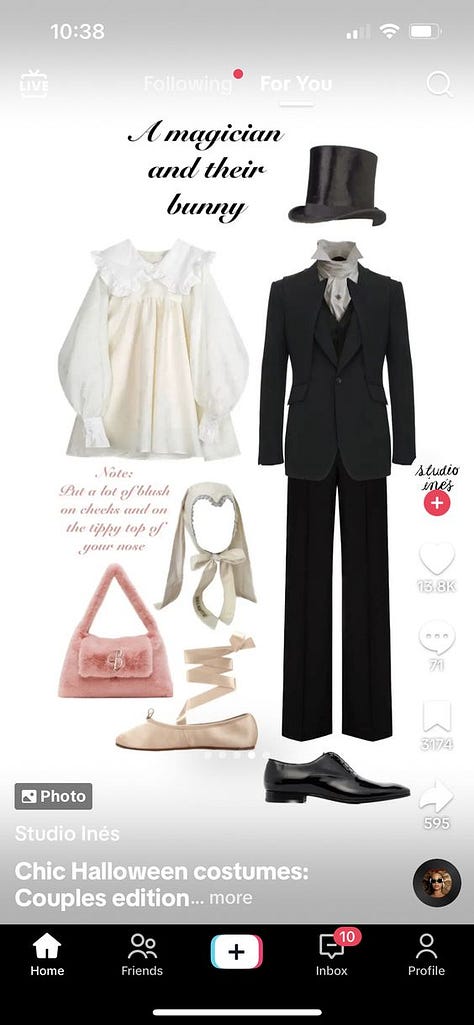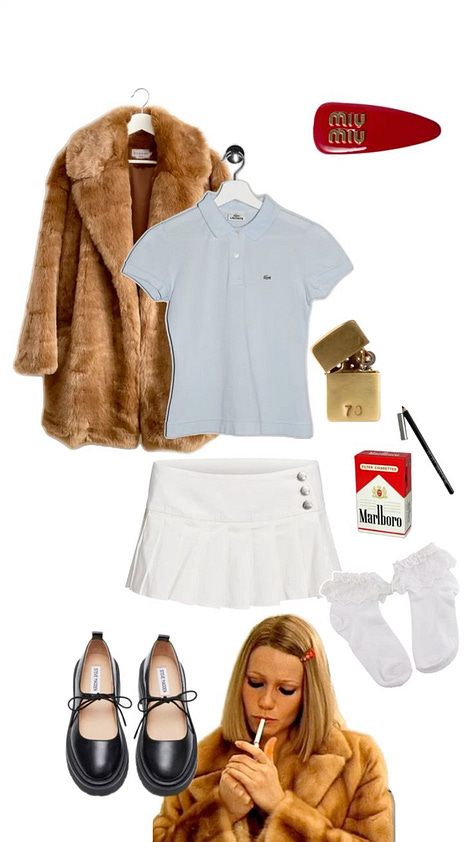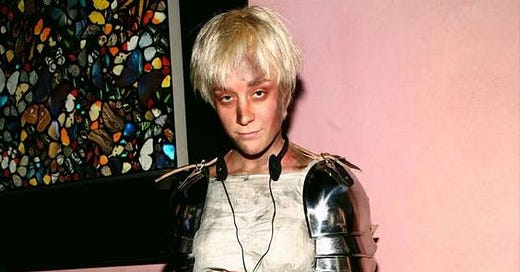I’ve always felt drawn to Halloween. What girl obsessed with ritual and the fashioning of identity isn’t? Maybe, as kids, we shared a similar experience; no matter the time of year, I’d close my eyes in the bath and believe, the way you believe in what’s in front of you, that when I opened them, I’d have transformed into a mermaid. Back then, there was something about the air around Halloween that felt especially powerful—more authentic, alive, transformative. As cliche as it sounds, that was the magic of the holiday; a day we understand as one where we can become someone we’re not, or maybe even someone we are, deep down.
As I’ve grown and come to terms with the reality that I will never morph into a mermaid in my bathtub, I’ve sought the spirit of death and rebirth in other things, the biggest of them being fashion. As a member of different online fashion communities, I’ve noticed something particularly sweet this year in the atmosphere around Halloween. Maybe it’s because I’m more connected than ever with people who love clothing and curation, or maybe it’s because, collectively, we’re bringing that magic back to life.



All month, I’ve seen people dress up as niche fashion history figures, iconic runway moments, and looks inspired by specific designers, all reimagined in the name of Halloween. Even simpler costumes, like the classic clown mermaid or witch have become the subjects of photo collages rooted in a sense of chicness, rich fashion history, and real clothing, that often reflect the wearers awareness of identity and style. These costumes, though worn for Halloween, are often born from the wearers’ personal wardrobe and feel like homages to the ritual of fashion itself and connected to something more sacred, more deeply believed.
Prior to the commercialization of Halloween, people understood how October 31st was a day linked to death and spirit. Their costumes, while meant to disguise them as figures from the realm beyond, were still familiar to them and their mortality.
“People in rural America really embraced its pagan roots, and the idea of it as a dark occasion, centered around death. They wore scary, frightening get-ups, which were made at home with whatever was on hand: sheets, makeup, improvised masks” - Nancy Diehl, fashion historian and director of Costume Studies at NYU.
Halloween’s tradition is rooted in the Celtic pagan festival of Samhain and the practice of wearing frightening costumes to confuse and repel evil spirits. It began as a spiritual event with dressing and transformation at its core. While most of us aren’t warding off spirits when we dress as Shalom Harlow post-paint-performance from Alexander McQueen’s Spring 1999 show, Halloween still transforms us. Into the feeling we get when we witness such a performance for the first time and we become infused with the essence of the transformation happening before us… Everyday dressing is a ritual of transformation and using our wardrobe to costume on Halloween heightens this ritual, bridging us and our clothing with a momentary death and rebirth.
For years Halloween hasn’t had the same magic it used to—a fire dampened by the fast-fashion-ification of costumes. But this year feels different. It somehow feels like the beginning of a holiday returned to its sartorial spirit. Once a celebration of the harvest and a Pagan spiritual practice to ward away spirits, then a night for playful imitation, Halloween today feels like a deeper aesthetic-driven ritual for worship, both in the traditional sense and in a kind of reverence for our personal mythology.
That’s what the costumes I’ve encountered this year feel like—there’s a circularity in both history and practice. For years, anonymity was a huge part of Halloween costumes; the spirit haunting my home wouldn’t be able to tell it’s me, nor would that person at the party I’ve been avoiding talking to. Now, it feels like during Halloween, the veil between our physical and spiritual selves thins for a day. For those of us transcendentally connected to our clothing, Halloween becomes an artistic exercise in identity and an opportunity to explore fashion’s spiritual nature. It’s interesting to see how trends shift and how they allow us to reimagine the ways we worship, transform, hide, and use clothes to both separate and connect us from ourselves.
I myself am dressed up as a black teddy goat today, which I will allow to be interpreted as either Black Phillip from The Witch (2015) or this plush toy made by an artisan in Ukraine that I’m enamored with. And maybe when the clock strikes midnight, I will assume my final form as gothic goat.





I used to do rituals in my bathtub to try to turn into a mermaid. I love you lol
I love that people are getting on board with shopping their closets for their Halloween costumes. It’s always been my favourite way to craft a look.
Excellent article, thank you so much .🎃